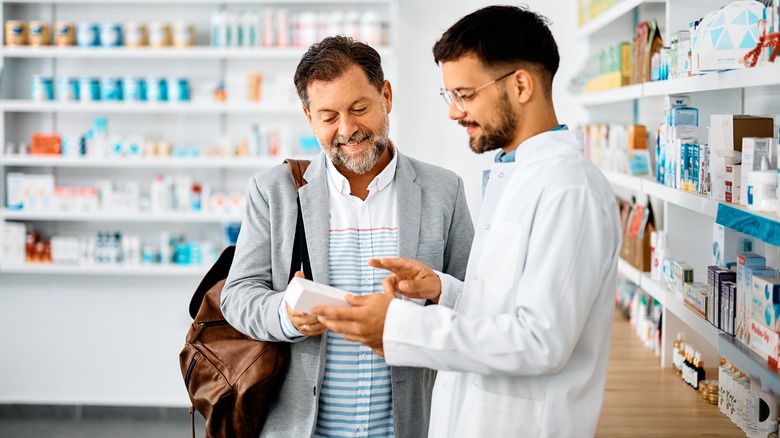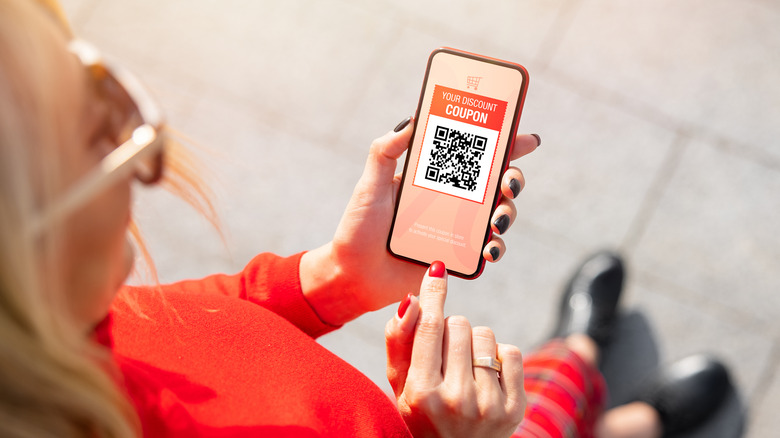What To Know About Getting Medications Without Insurance
About one in 10 non-elderly people in the United States don't have insurance, mostly because paying for insurance that's not covered by a job can be expensive (via Kaiser Family Foundation). This can leave people without insurance unable to afford necessary medical care, such as medications. Paying for medications for chronic conditions without insurance can significantly strain your budget, especially if your prescription is for a chronic condition. For example, gabapentin is used to treat epilepsy and nerve pain. Without insurance, this medication can cost about $80, whereas it could be free or much lower if you do have insurance. Atorvastatin helps reduce cholesterol and costs, on average, about $64 a month.
People in the United States spend more money — more than $1,000 a year — on prescription drugs than any other nation in the world, according to the University of California, San Diego. What's sneaky is that prescription drugs aren't always cheaper if you do have insurance, according to KHealth. That's because different insurance companies negotiate deals with pharmaceutical companies on how much people should pay for their prescriptions. Here are a few things to know to help you save money on your prescriptions, even if you don't have insurance.
Ask for generic
Some brand-name prescription drugs can be much more costly than the generic versions. For example, the diuretic furosemide is a prescription drug used to treat excess fluid in the body or heart failure. Lasix, which is the brand-name version of furosemide, can set you back more than $100 for a 40-milligram bottle of 90 tablets. If you ask for a generic, you'll pay roughly $5, depending on where you shop.
Getting a brand-name version of a prescription doesn't mean it works better than the generic, according to the Food and Drug Administration. Generic medications go through the same approval process as their brand-name counterpart, and have the same active ingredient and potency. Because generic drugs don't have to pay for the clinical trials that brand-name drugs do, they're offered at a much lower cost. The more generic versions of a drug on the market, the cheaper the cost of that drug because they all compete in the marketplace. This can save you as much as 85% on a prescription.
Find private and public assistance programs
It's possible you can get your prescription drugs for free (or almost free) through different programs. Some states offer local resources on their websites for their residents to get financial assistance for their prescription drugs. For example, the Maryland Medbank helps residents in the state of Maryland get free prescriptions if they're not included with their insurance or they're not enrolled in another entitlement program. While some of these prescriptions are stocked in their pharmacy, the organization will connect with a drug company to obtain other medications.
The Medicine Assistance Tool helps people become aware of about 900 available public and private assistance programs. Created by the Pharmaceutical Research and Manufacturers of America, its search engine will have you list your medications and then show resources based on your age, state, household income, and whether you're a U.S. resident. If your income is less than $21,870 a year, you can apply for the Extra Help program through the Medicare program. This program lets you pay the Medicare prices for prescription drugs, which can be as low as $4.15 for a generic drug and $10.35 for a brand-name drug.
Shop different pharmacies
You might find significant differences in the prices of a single drug if you take a drive around town. A Consumer Reports investigation sent secret shoppers to various pharmacies in six cities to ask for the non-insured price of five popular medications. The combo of these medications could be as low as $66 at an online pharmacy or $105 at Costco. Walgreens sold the drugs for $752, Rite Aid had an $866 price tag, and CVS had the highest price at $928.
However, if you really like your local pharmacy, some will discount your drug prices through loyalty programs or by visiting them in the store. Walgreens has a prescription savings club for $20 a year for an individual and $35 for families. The program gives you discounts for more than 8,000 medications that could be cheaper even if you do have an insurance copayment. For example, you can get the generic version of the diabetes medication Metformin for $7.50 under the plan compared to the regular price of $13.99. If you have an account with CVS, you can search for savings on your prescriptions or ask for options in the store. If you don't have an account, you can search for third-party discounts to see if your specific medication has offers to help offset your drug costs.
Coupons from websites
Rather than spending a ton of time scouring various pharmacies for coupons and discounts, some websites have made it much easier. RxSaver allows you to access coupons just by searching for your specific medication, strength, and quantity. For example, you can get a coupon for a 30-tablet bottle of 100-milligram Zoloft at Safeway for about $423. The site also allows you to compare generic options. The generic version of Zoloft, sertraline, can be as low as $8.62 with a coupon from Wegmans.
GoodRx does the same thing, but it will look for discounts at the popular pharmacies in your zip code. Although Viagra is well-known for helping people with erectile dysfunction, the generic form, sildenafil, can help with pulmonary hypertension. You can save 98% off sildenafil with a coupon from your local Rite Aid, or 77% with a coupon from CVS. All the coupons are free from GoodRx, but you can subscribe to GoodRx Gold, which can save you the most on your generic prescription drugs.
Contact the drug manufacturer
Pharmaceutical companies will also offer you discounts on certain medications if you don't have insurance or do not have enough insurance to cover the cost of a specific medication. For example, Pfizer has the Pfizer Patient Assistance Program for people whose household income falls below a specific threshold. The program offers prescriptions for free or at cost. You must fill out an application for the program to see if you are eligible for the discounted prescription. Pfizer has other programs through its Pfizer RxPathways that offer additional resources for paying for your Pfizer medications, such as savings cards.
If you can't afford the diabetes drug Ozempic, the drug's manufacturer, Novo Nordisk, has a Patient Assistance Program to receive this medication (and other insulin prescriptions) at no cost. This program is for people living in the United States whose income is below a certain level and who have no insurance. You and your healthcare provider have to complete an application, but once approved, Novo Nordisk will ship your prescription to your healthcare provider's office.






